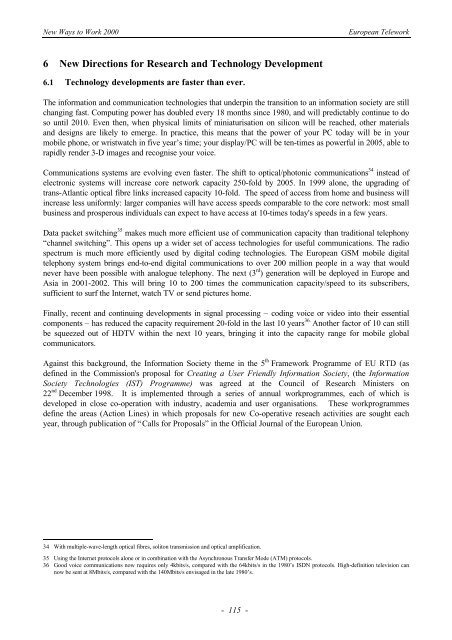eWORK 2000 - European Telework Week
eWORK 2000 - European Telework Week
eWORK 2000 - European Telework Week
- No tags were found...
You also want an ePaper? Increase the reach of your titles
YUMPU automatically turns print PDFs into web optimized ePapers that Google loves.
New Ways to Work <strong>2000</strong><strong>European</strong> <strong>Telework</strong>6 New Directions for Research and Technology Development6.1 Technology developments are faster than ever.The information and communication technologies that underpin the transition to an information society are stillchanging fast. Computing power has doubled every 18 months since 1980, and will predictably continue to doso until 2010. Even then, when physical limits of miniaturisation on silicon will be reached, other materialsand designs are likely to emerge. In practice, this means that the power of your PC today will be in yourmobile phone, or wristwatch in five year’s time; your display/PC will be ten-times as powerful in 2005, able torapidly render 3-D images and recognise your voice.Communications systems are evolving even faster. The shift to optical/photonic communications 34 instead ofelectronic systems will increase core network capacity 250-fold by 2005. In 1999 alone, the upgrading oftrans-Atlantic optical fibre links increased capacity 10-fold. The speed of access from home and business willincrease less uniformly: larger companies will have access speeds comparable to the core network: most smallbusiness and prosperous individuals can expect to have access at 10-times today's speeds in a few years.Data packet switching 35 makes much more efficient use of communication capacity than traditional telephony“channel switching”. This opens up a wider set of access technologies for useful communications. The radiospectrum is much more efficiently used by digital coding technologies. The <strong>European</strong> GSM mobile digitaltelephony system brings end-to-end digital communications to over 200 million people in a way that wouldnever have been possible with analogue telephony. The next (3 rd ) generation will be deployed in Europe andAsia in 2001-2002. This will bring 10 to 200 times the communication capacity/speed to its subscribers,sufficient to surf the Internet, watch TV or send pictures home.Finally, recent and continuing developments in signal processing – coding voice or video into their essentialcomponents – has reduced the capacity requirement 20-fold in the last 10 years 36. Another factor of 10 can stillbe squeezed out of HDTV within the next 10 years, bringing it into the capacity range for mobile globalcommunicators.Against this background, the Information Society theme in the 5 th Framework Programme of EU RTD (asdefined in the Commission's proposal for Creating a User Friendly Information Society, (the InformationSociety Technologies (IST) Programme) was agreed at the Council of Research Ministers on22 nd December 1998. It is implemented through a series of annual workprogrammes, each of which isdeveloped in close co-operation with industry, academia and user organisations. These workprogrammesdefine the areas (Action Lines) in which proposals for new Co-operative reseach activities are sought eachyear, through publication of “Calls for Proposals” in the Official Journal of the <strong>European</strong> Union.34 With multiple-wave-length optical fibres, soliton transmission and optical amplification.35 Using the Internet protocols alone or in combination with the Asynchronous Transfer Mode (ATM) protocols.36 Good voice communications now requires only 4kbits/s, compared with the 64kbits/s in the 1980’s ISDN protocols. High-definition television cannow be sent at 8Mbits/s, compared with the 140Mbits/s envisaged in the late 1980’s.- 115 -








